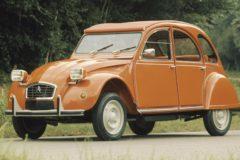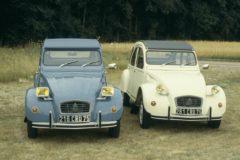It was in 2018 seventy years ago that Citroën introduced a special car at the Paris Salon: the 2CV. The French jubilee was skeptically received by the international press, and caught on with the general public. In the first two parts we described the career from the 2CV to 1974. In the final piece we describe the period from 1974 to 1990, the year that the production of the 2CV came to an end in Mangualde, Portugal.
In 1974 it is clear that the 2CV will last a long life. The intended successor - the Dyane - has mainly become a fully-fledged addition to the 2 cylinder range Citroëns, in which the 2CV continues to sing its own song. Point anyway Citroën for model year 1975 her stronghold in the small class again, and not always to the satisfaction of the purist, who actually had difficulty with the earlier farewell of the AZ models.
Changed face
Towards the mid-seventies, the 2CV gets a changed face. The most important modification: the round headlights disappeared, and rectangular units replaced them. Motorically there is nothing new under the sun. The 435 cc and 602cc engines continue to serve in the 2CV4 and the 2CV6. The engines are now switched on with a key instead of the old start button, the starter ring has been improved in the meantime, the choke lever has been moved and the interior plastics used are turning brown.
Back in time: the 2 CV Special
In 1975 decision Citroën but also to go back in time: the 2 CV Special is on the market. This is a simplified 2cv4 with round headlights, narrow rear bumper, the old type of speedometer, and simplified furniture. The 2 CV Special, which is available exclusively in Jaune Cedrat, also lacks the 3rd rear window, aluminum strips on the door and is equipped with plastic door covers. Meanwhile, the frotteurs and batteurs have been replaced by telescopic shock absorbers on all 2CV models, and the 2CV6 and later the 2CV4 also get a changed steering gear, which is later also available on the 2CV Special.
Action models
In the second half of the seventies, the time of action models arrived. The white-orange Spot is a well-known attempt to keep the 2CV4 popular and is being produced in an edition of 1800 pieces. Final decision Citroën in 1978 to take the currently smallest motorized 2CV out of production, sales have plummeted in a period that the 2CV4 can keep up with the traffic less and less. That 435 cc engine is still available in the 2CV Special, but it also gets an upgrade. Not only does the 2CV4 disappear, the order variant of the 2CV is also being retired and replaced by the likeable Acadiane. In 1979, the third side window is also mounted in the Special and the slip-on gets the 602cc engine. From that moment he is called 2CV6 Special, while the regular 602cc variant is christened in 2CV6 Club. Outward appearance: the Special keeps the round headlights, the Club keeps the square ones.
The eighties, Charleston and disc brakes
That's how the 2CV6 goes into the eighties. It will be the Charleston era in particular, a Duck painted in two colors with the necessary classic chrome elements and a luxurious upholstery. The Charleston initially made its debut as an action model with red round headlights, a black-red color scheme and black-and-white trim. In this trim, the 2CV catches on, and from model year 1982, the Charleston becomes a regular guest in the 2CV range, with chrome headlights and gray upholstery patterned diamond pattern. The Charleston benefits from a major modification in the 2CV program, as the fall of 1981 brings disc brakes to the front wheels.
Regular guest and new action models
The Charleston thus becomes a regular in the range, but it does not alter that Citroën continues to come up with various action models. The 007 edition (inspired by the 2CVs from the James Bond movie For Your Eyes Only, but not with the 1015cc engine from the GS) is popular, and in 1983 the MIXTE (with fifth door) returns temporarily, the Transat and the Cocorico are other acquaintances. The Dolly from 1985 is a popular action model based on the 2CV6 Special, which has a color combination of two fresh shades. In addition, it is possible to convert the 2CV to an 4 x 4 vehicle, because Barbour focuses on the manufacture and delivery of these configuration sets. Today, this application of four-wheel drive in a specific circle is still loved. The Dutchman Frank Hensen described for example in a beautiful book, how he are 2CV 4 x 4 dream achieved.
2CV survives successor
The 2CV successor, the Citroën Dyane, disappears in 1984. The 2CV thus survives the model from 1967, but in the second half of the eighties, the farewell comes carefully. The Club disappears from the program in 1987, the 2CV6 Special takes over some of the characteristics of the more luxurious brother, such as the larger rear bumper. The Charleston accompanies the 2CV6 Special until the summer of 1990.
Beloved minimalist for everyone
The 2CV has not been produced in France for a few years since 1988. The very last 2CV (a Charleston sprayed in two shades of gray) rolls off 27 on July 1990 in Mangualde, Portugal. For example, after a production of a total of 5.1 million 2CV copies (including order versions), an episode comes to an end in which the world was able to become acquainted with a car for a long time, combining functionality, driving comfort and minimalism with a pleasantly basic form of French. automobile freedom. And over the years it was always good for a social and time-bound statement. Today it does this Citroën again, because nowadays an 2CV is an extremely popular and expensive classic that appeals to countless enthusiasts and constructors from all walks of life. As an original car or as a donor to the technology.















Very clever to briefly summarize so much history, with so many models and changes. That alone deserves a compliment. Very nice to read that the Barbour is called 4 × 4. I did not expect that. Thanks.
Is and remains idd the only car for which I left the lease car of the boss when I got home and continued with it. In the meantime idd have become too expensive for me. Also have no garage at my disposal. Lesson from the duck we had was that they can really rust. And because we had no money for a rolling new chassis, he went to the demolition. Hfl 2000 was then too much money.